Research Proposal: Factors Influencing Youth Towards Luxury Products
VerifiedAdded on 2020/03/16
|9
|1586
|34
Report
AI Summary
This research proposal investigates the factors influencing youth consumption of luxury products. It begins with an introduction highlighting the ambiguity of luxury and its impact on young consumers. The research objectives aim to determine youth attitudes, review literature on purchase intention, explore the relationship between attitude and purchase intention, determine popular products, and examine the relationship between product quality and buying behavior. The literature review defines luxury goods and explores the relationship between quality, attitude, and buying behavior. The methodology outlines the use of primary and secondary data collection methods, including surveys and interviews, utilizing a deductive research approach. The sampling strategy targets young adults aged 19-35. The quantitative approach will employ surveys with Likert-scale questionnaires, and the qualitative approach will use open-ended questionnaires. The conclusion anticipates that factors like high income and social status will increase luxury goods consumption and a positive attitude will increase consumption. The references include relevant academic sources.
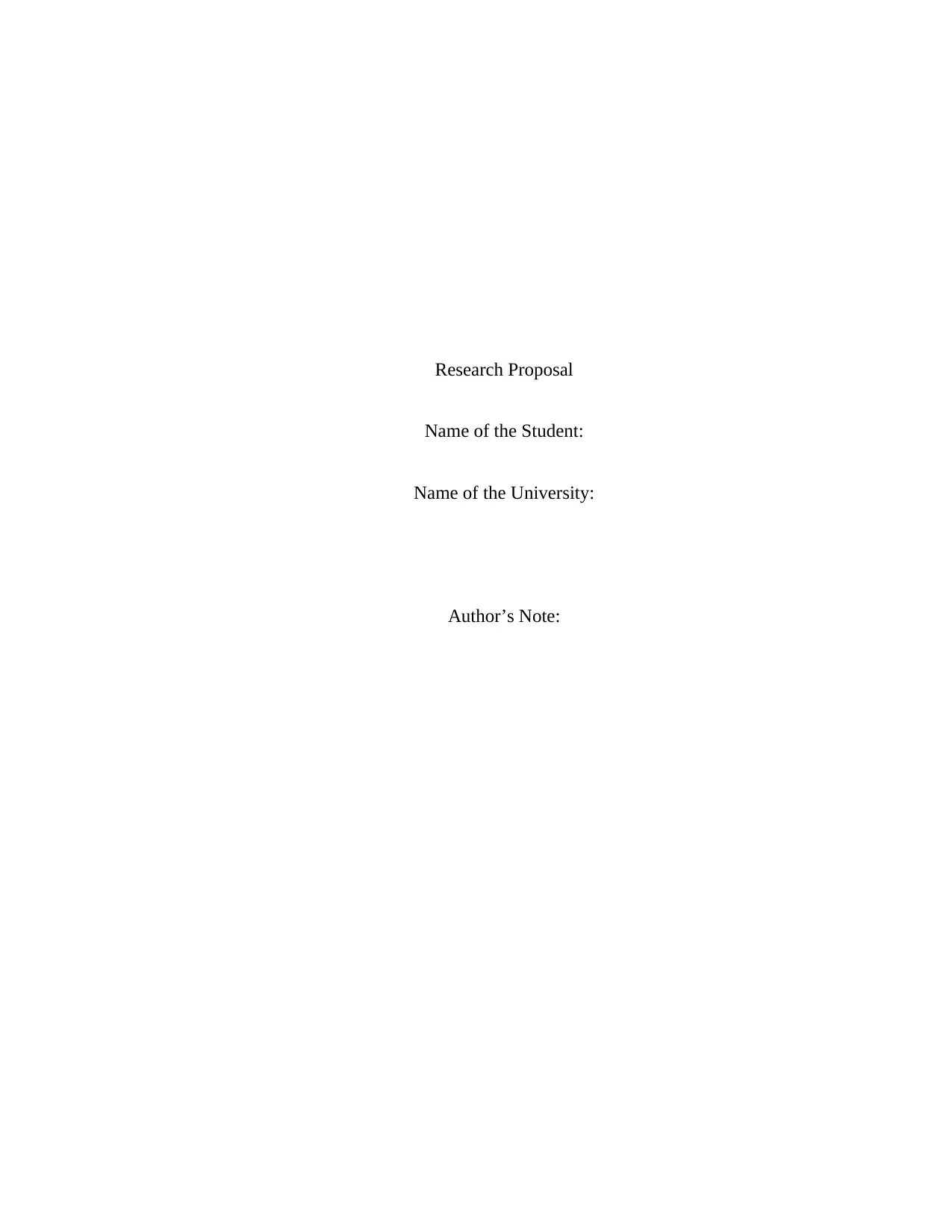
Research Proposal
Name of the Student:
Name of the University:
Author’s Note:
Name of the Student:
Name of the University:
Author’s Note:
Paraphrase This Document
Need a fresh take? Get an instant paraphrase of this document with our AI Paraphraser
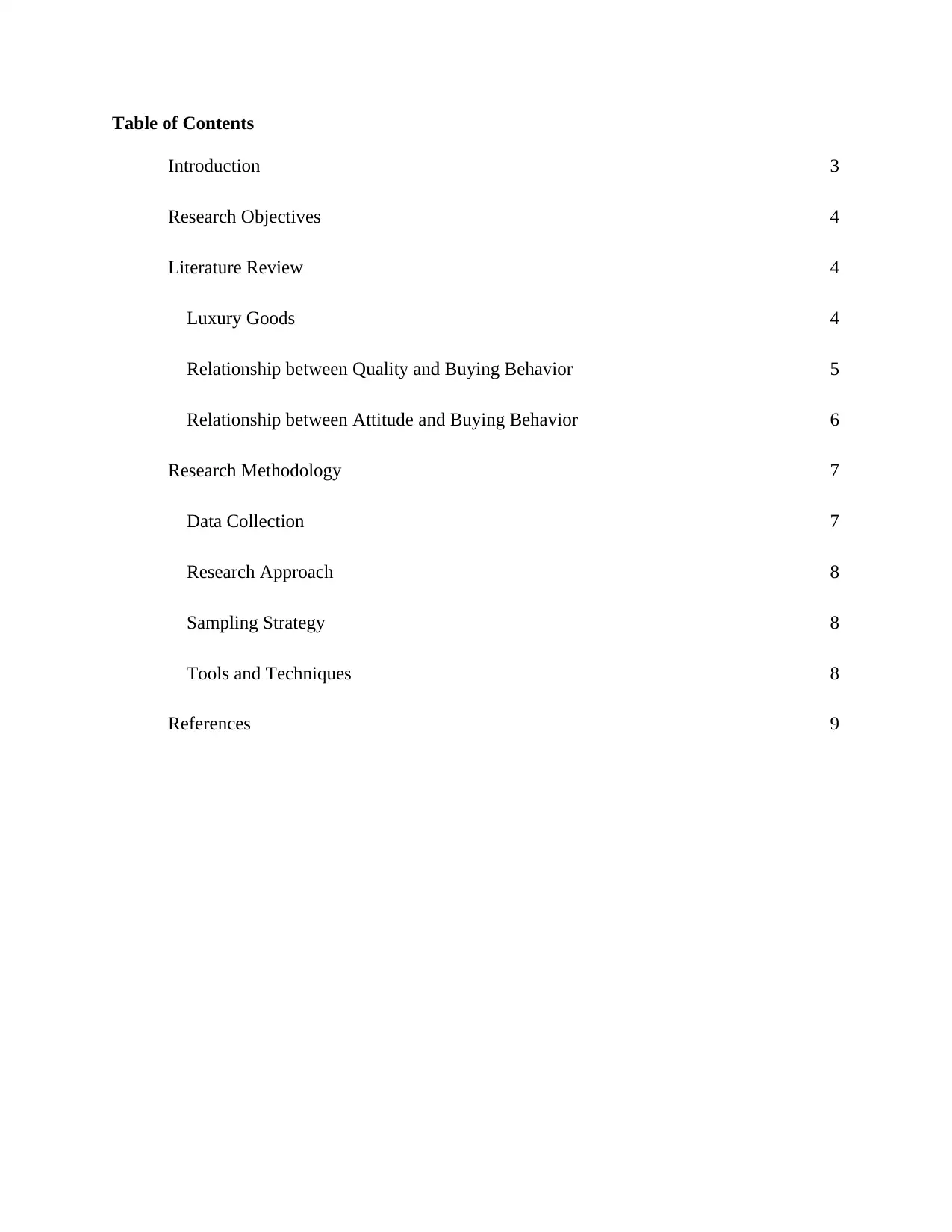
Table of Contents
Introduction 3
Research Objectives 4
Literature Review 4
Luxury Goods 4
Relationship between Quality and Buying Behavior 5
Relationship between Attitude and Buying Behavior 6
Research Methodology 7
Data Collection 7
Research Approach 8
Sampling Strategy 8
Tools and Techniques 8
References 9
Introduction 3
Research Objectives 4
Literature Review 4
Luxury Goods 4
Relationship between Quality and Buying Behavior 5
Relationship between Attitude and Buying Behavior 6
Research Methodology 7
Data Collection 7
Research Approach 8
Sampling Strategy 8
Tools and Techniques 8
References 9
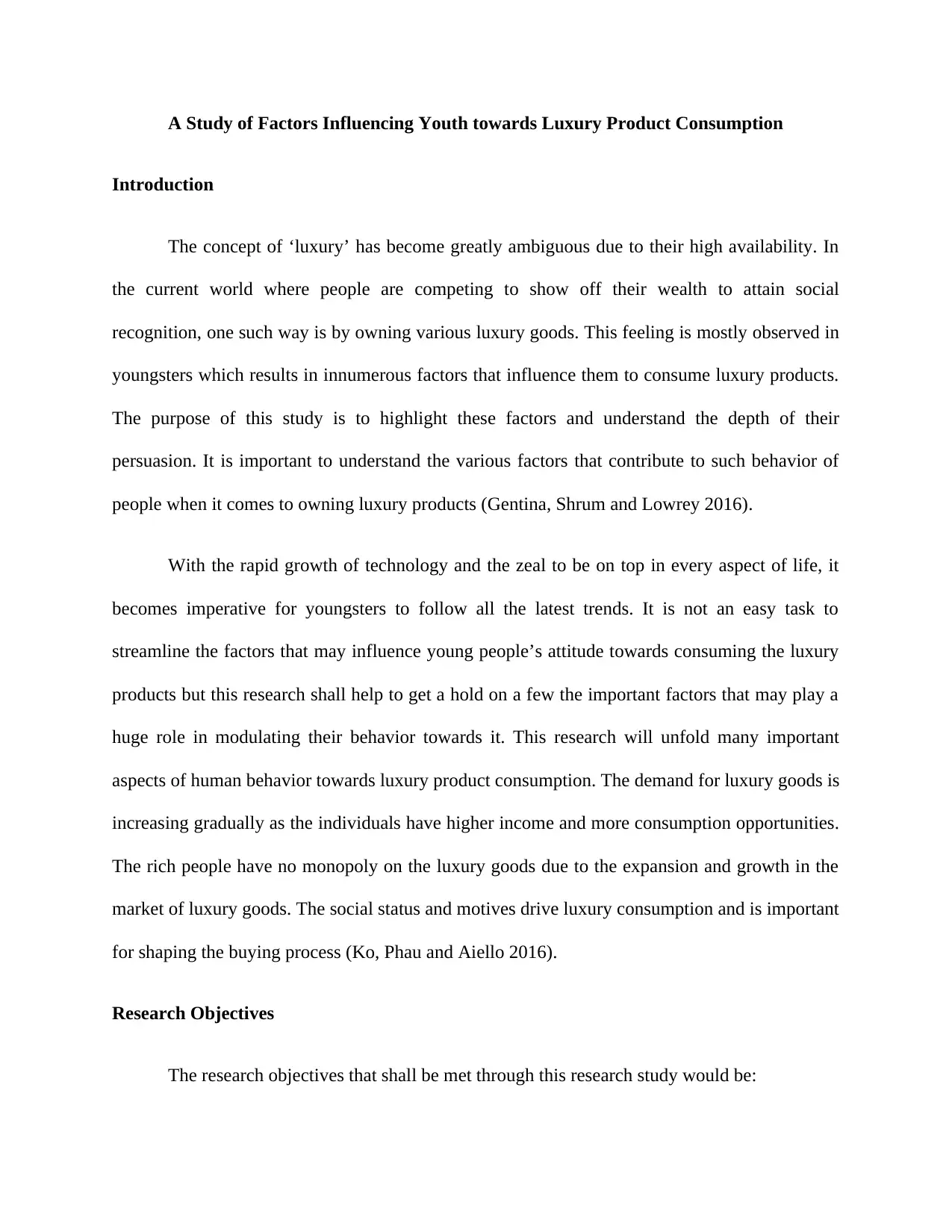
A Study of Factors Influencing Youth towards Luxury Product Consumption
Introduction
The concept of ‘luxury’ has become greatly ambiguous due to their high availability. In
the current world where people are competing to show off their wealth to attain social
recognition, one such way is by owning various luxury goods. This feeling is mostly observed in
youngsters which results in innumerous factors that influence them to consume luxury products.
The purpose of this study is to highlight these factors and understand the depth of their
persuasion. It is important to understand the various factors that contribute to such behavior of
people when it comes to owning luxury products (Gentina, Shrum and Lowrey 2016).
With the rapid growth of technology and the zeal to be on top in every aspect of life, it
becomes imperative for youngsters to follow all the latest trends. It is not an easy task to
streamline the factors that may influence young people’s attitude towards consuming the luxury
products but this research shall help to get a hold on a few the important factors that may play a
huge role in modulating their behavior towards it. This research will unfold many important
aspects of human behavior towards luxury product consumption. The demand for luxury goods is
increasing gradually as the individuals have higher income and more consumption opportunities.
The rich people have no monopoly on the luxury goods due to the expansion and growth in the
market of luxury goods. The social status and motives drive luxury consumption and is important
for shaping the buying process (Ko, Phau and Aiello 2016).
Research Objectives
The research objectives that shall be met through this research study would be:
Introduction
The concept of ‘luxury’ has become greatly ambiguous due to their high availability. In
the current world where people are competing to show off their wealth to attain social
recognition, one such way is by owning various luxury goods. This feeling is mostly observed in
youngsters which results in innumerous factors that influence them to consume luxury products.
The purpose of this study is to highlight these factors and understand the depth of their
persuasion. It is important to understand the various factors that contribute to such behavior of
people when it comes to owning luxury products (Gentina, Shrum and Lowrey 2016).
With the rapid growth of technology and the zeal to be on top in every aspect of life, it
becomes imperative for youngsters to follow all the latest trends. It is not an easy task to
streamline the factors that may influence young people’s attitude towards consuming the luxury
products but this research shall help to get a hold on a few the important factors that may play a
huge role in modulating their behavior towards it. This research will unfold many important
aspects of human behavior towards luxury product consumption. The demand for luxury goods is
increasing gradually as the individuals have higher income and more consumption opportunities.
The rich people have no monopoly on the luxury goods due to the expansion and growth in the
market of luxury goods. The social status and motives drive luxury consumption and is important
for shaping the buying process (Ko, Phau and Aiello 2016).
Research Objectives
The research objectives that shall be met through this research study would be:
⊘ This is a preview!⊘
Do you want full access?
Subscribe today to unlock all pages.

Trusted by 1+ million students worldwide

To determine the attitude of young people towards luxury products consumption.
To review the literature on the factors that enhances purchase intention amongst the
youth.
To explore the relationship between attitude and purchase intention of luxury products.
To determine the nature of products mostly used by the youth and the reasons behind
their popularity.
To examine the relationship between quality of products and buying behavior of luxury
products.
Literature Review
Luxury Goods
The three basic classes of goods are: luxury, inferior and needs. According to Songer
(2014), the basic necessities such as food and accommodation own the biggest market share. The
consumption of goods increases with the increase in people’s income. The words luxury is
derived from the Latin word ‘luxus’ that means ‘comfort, abundance, soft living’. According to
Ajitha and Sivakumar (2017), luxury products have a limited supply. From the perspective of
economics, luxury goods are categorized as luxury on the needs depending on elasticity (Tuu,
Olsen and Cong 2017).
Relationship between Quality and Buying Behavior
The consumers have a tendency to not only consider the performance of the product, but
also the quality. Quality performance has been applied in various contexts and at different key
To review the literature on the factors that enhances purchase intention amongst the
youth.
To explore the relationship between attitude and purchase intention of luxury products.
To determine the nature of products mostly used by the youth and the reasons behind
their popularity.
To examine the relationship between quality of products and buying behavior of luxury
products.
Literature Review
Luxury Goods
The three basic classes of goods are: luxury, inferior and needs. According to Songer
(2014), the basic necessities such as food and accommodation own the biggest market share. The
consumption of goods increases with the increase in people’s income. The words luxury is
derived from the Latin word ‘luxus’ that means ‘comfort, abundance, soft living’. According to
Ajitha and Sivakumar (2017), luxury products have a limited supply. From the perspective of
economics, luxury goods are categorized as luxury on the needs depending on elasticity (Tuu,
Olsen and Cong 2017).
Relationship between Quality and Buying Behavior
The consumers have a tendency to not only consider the performance of the product, but
also the quality. Quality performance has been applied in various contexts and at different key
Paraphrase This Document
Need a fresh take? Get an instant paraphrase of this document with our AI Paraphraser
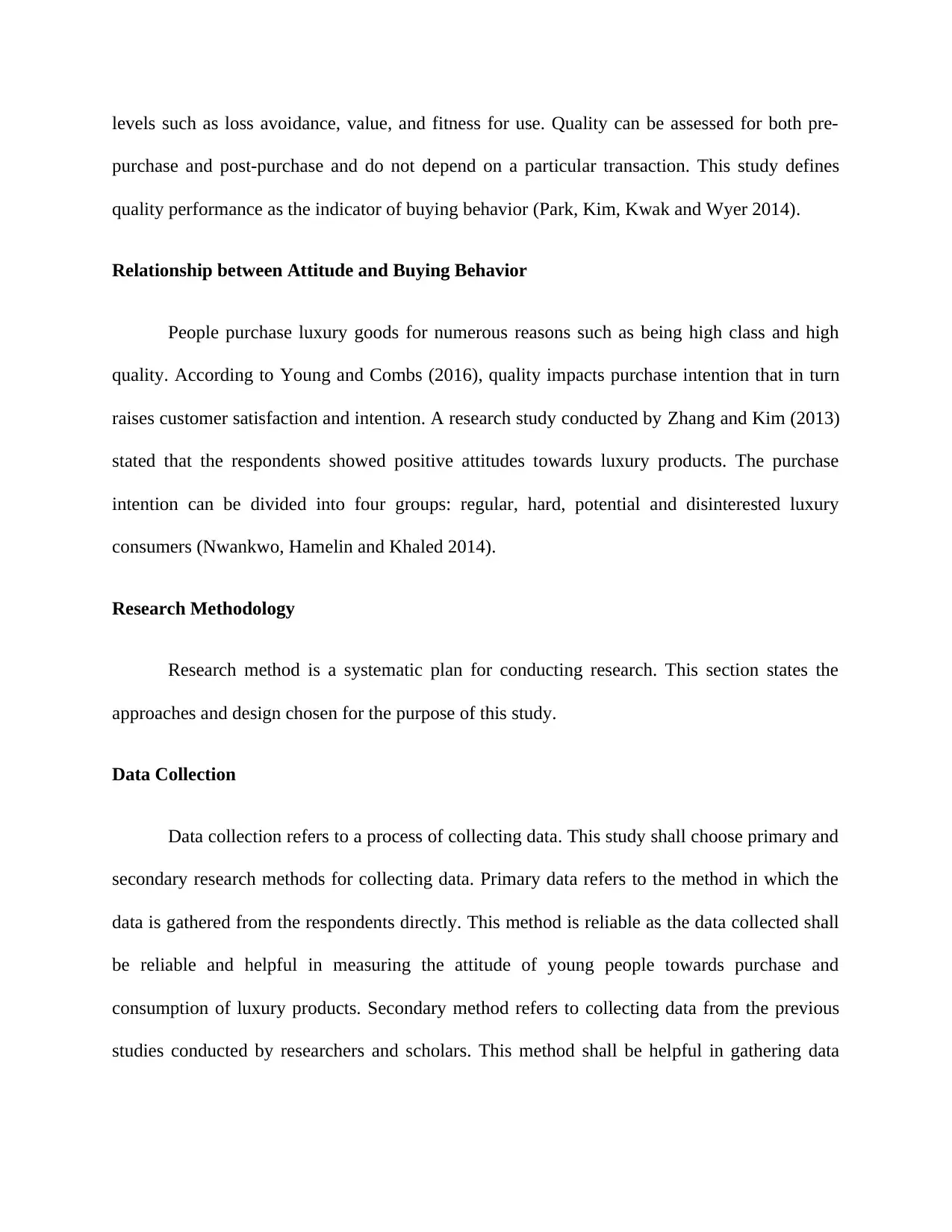
levels such as loss avoidance, value, and fitness for use. Quality can be assessed for both pre-
purchase and post-purchase and do not depend on a particular transaction. This study defines
quality performance as the indicator of buying behavior (Park, Kim, Kwak and Wyer 2014).
Relationship between Attitude and Buying Behavior
People purchase luxury goods for numerous reasons such as being high class and high
quality. According to Young and Combs (2016), quality impacts purchase intention that in turn
raises customer satisfaction and intention. A research study conducted by Zhang and Kim (2013)
stated that the respondents showed positive attitudes towards luxury products. The purchase
intention can be divided into four groups: regular, hard, potential and disinterested luxury
consumers (Nwankwo, Hamelin and Khaled 2014).
Research Methodology
Research method is a systematic plan for conducting research. This section states the
approaches and design chosen for the purpose of this study.
Data Collection
Data collection refers to a process of collecting data. This study shall choose primary and
secondary research methods for collecting data. Primary data refers to the method in which the
data is gathered from the respondents directly. This method is reliable as the data collected shall
be reliable and helpful in measuring the attitude of young people towards purchase and
consumption of luxury products. Secondary method refers to collecting data from the previous
studies conducted by researchers and scholars. This method shall be helpful in gathering data
purchase and post-purchase and do not depend on a particular transaction. This study defines
quality performance as the indicator of buying behavior (Park, Kim, Kwak and Wyer 2014).
Relationship between Attitude and Buying Behavior
People purchase luxury goods for numerous reasons such as being high class and high
quality. According to Young and Combs (2016), quality impacts purchase intention that in turn
raises customer satisfaction and intention. A research study conducted by Zhang and Kim (2013)
stated that the respondents showed positive attitudes towards luxury products. The purchase
intention can be divided into four groups: regular, hard, potential and disinterested luxury
consumers (Nwankwo, Hamelin and Khaled 2014).
Research Methodology
Research method is a systematic plan for conducting research. This section states the
approaches and design chosen for the purpose of this study.
Data Collection
Data collection refers to a process of collecting data. This study shall choose primary and
secondary research methods for collecting data. Primary data refers to the method in which the
data is gathered from the respondents directly. This method is reliable as the data collected shall
be reliable and helpful in measuring the attitude of young people towards purchase and
consumption of luxury products. Secondary method refers to collecting data from the previous
studies conducted by researchers and scholars. This method shall be helpful in gathering data
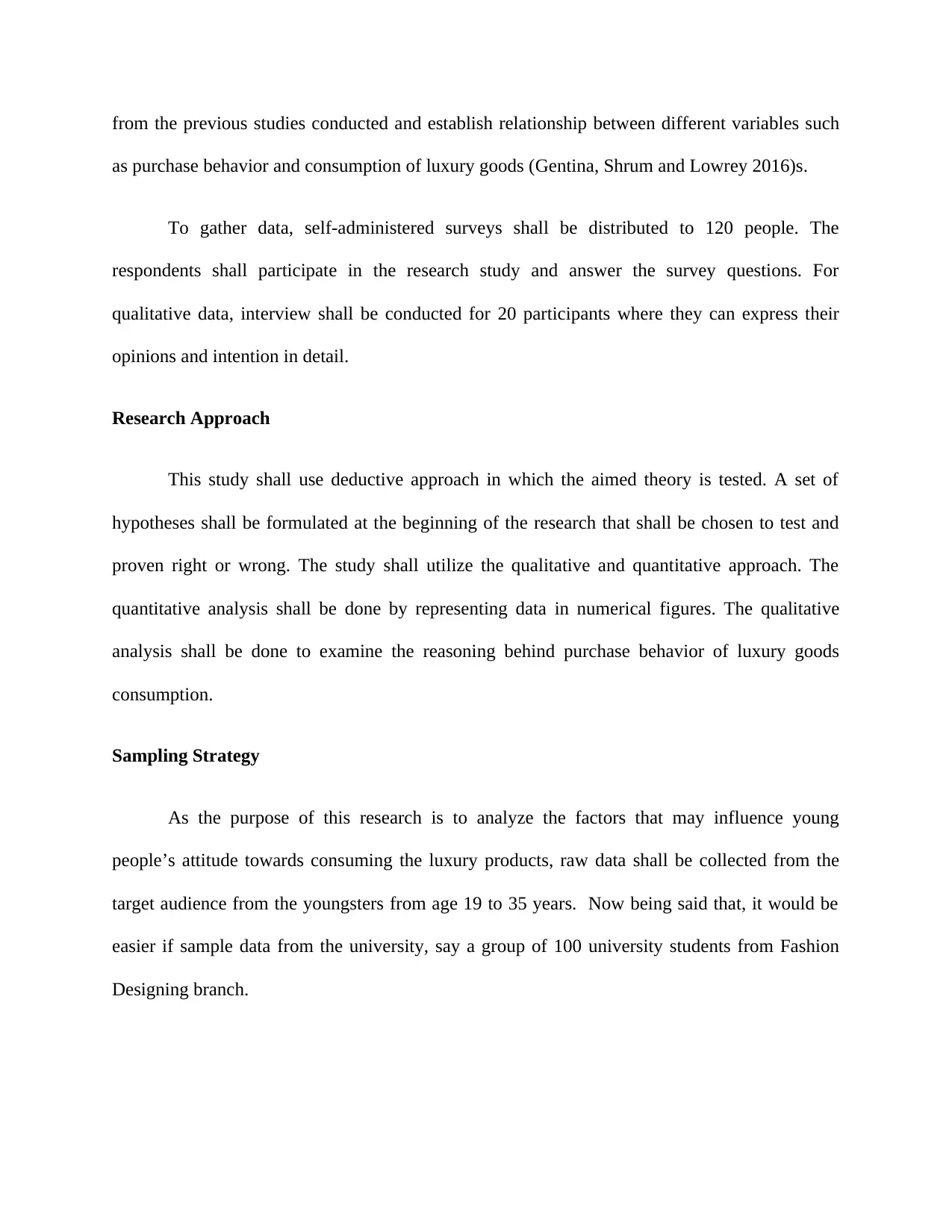
from the previous studies conducted and establish relationship between different variables such
as purchase behavior and consumption of luxury goods (Gentina, Shrum and Lowrey 2016)s.
To gather data, self-administered surveys shall be distributed to 120 people. The
respondents shall participate in the research study and answer the survey questions. For
qualitative data, interview shall be conducted for 20 participants where they can express their
opinions and intention in detail.
Research Approach
This study shall use deductive approach in which the aimed theory is tested. A set of
hypotheses shall be formulated at the beginning of the research that shall be chosen to test and
proven right or wrong. The study shall utilize the qualitative and quantitative approach. The
quantitative analysis shall be done by representing data in numerical figures. The qualitative
analysis shall be done to examine the reasoning behind purchase behavior of luxury goods
consumption.
Sampling Strategy
As the purpose of this research is to analyze the factors that may influence young
people’s attitude towards consuming the luxury products, raw data shall be collected from the
target audience from the youngsters from age 19 to 35 years. Now being said that, it would be
easier if sample data from the university, say a group of 100 university students from Fashion
Designing branch.
as purchase behavior and consumption of luxury goods (Gentina, Shrum and Lowrey 2016)s.
To gather data, self-administered surveys shall be distributed to 120 people. The
respondents shall participate in the research study and answer the survey questions. For
qualitative data, interview shall be conducted for 20 participants where they can express their
opinions and intention in detail.
Research Approach
This study shall use deductive approach in which the aimed theory is tested. A set of
hypotheses shall be formulated at the beginning of the research that shall be chosen to test and
proven right or wrong. The study shall utilize the qualitative and quantitative approach. The
quantitative analysis shall be done by representing data in numerical figures. The qualitative
analysis shall be done to examine the reasoning behind purchase behavior of luxury goods
consumption.
Sampling Strategy
As the purpose of this research is to analyze the factors that may influence young
people’s attitude towards consuming the luxury products, raw data shall be collected from the
target audience from the youngsters from age 19 to 35 years. Now being said that, it would be
easier if sample data from the university, say a group of 100 university students from Fashion
Designing branch.
⊘ This is a preview!⊘
Do you want full access?
Subscribe today to unlock all pages.

Trusted by 1+ million students worldwide
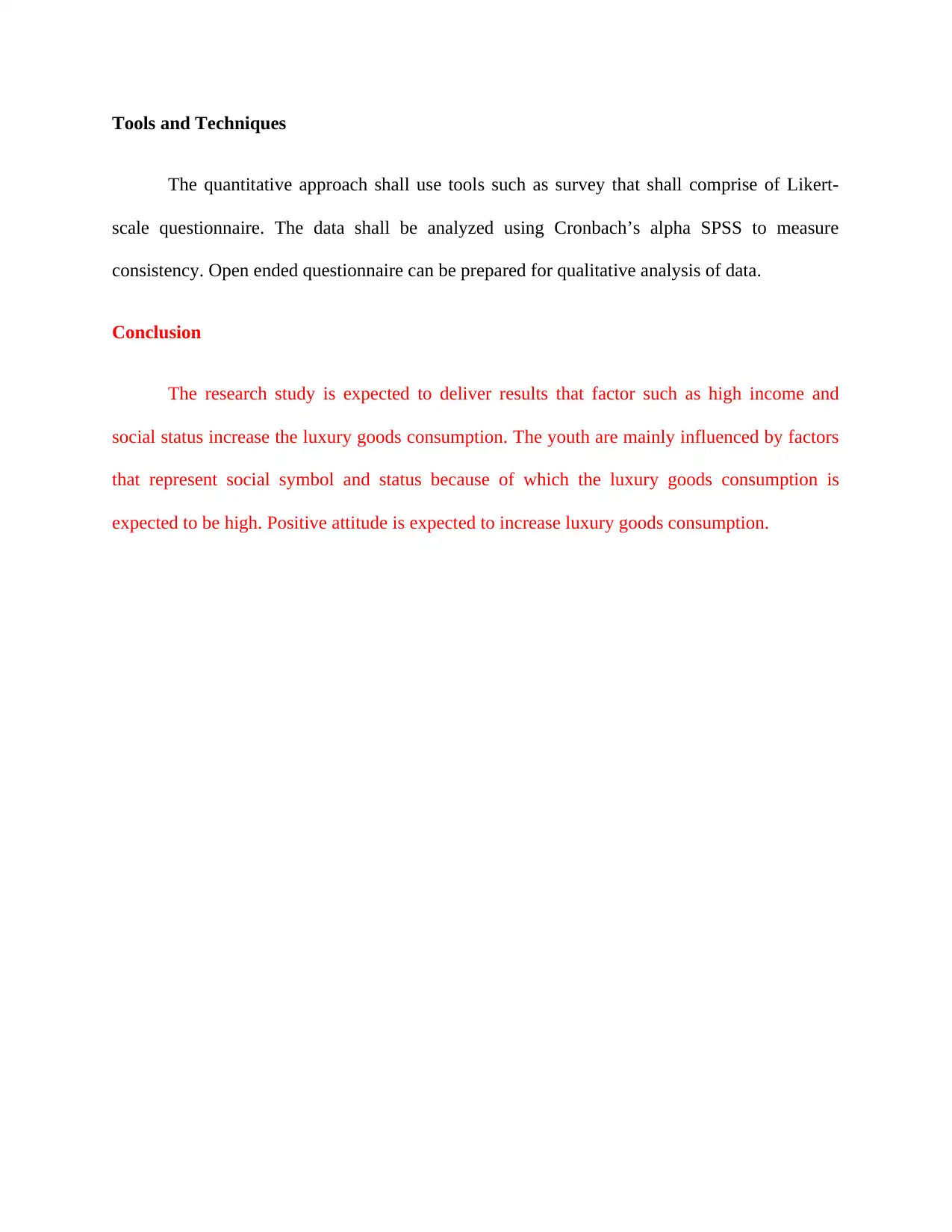
Tools and Techniques
The quantitative approach shall use tools such as survey that shall comprise of Likert-
scale questionnaire. The data shall be analyzed using Cronbach’s alpha SPSS to measure
consistency. Open ended questionnaire can be prepared for qualitative analysis of data.
Conclusion
The research study is expected to deliver results that factor such as high income and
social status increase the luxury goods consumption. The youth are mainly influenced by factors
that represent social symbol and status because of which the luxury goods consumption is
expected to be high. Positive attitude is expected to increase luxury goods consumption.
The quantitative approach shall use tools such as survey that shall comprise of Likert-
scale questionnaire. The data shall be analyzed using Cronbach’s alpha SPSS to measure
consistency. Open ended questionnaire can be prepared for qualitative analysis of data.
Conclusion
The research study is expected to deliver results that factor such as high income and
social status increase the luxury goods consumption. The youth are mainly influenced by factors
that represent social symbol and status because of which the luxury goods consumption is
expected to be high. Positive attitude is expected to increase luxury goods consumption.
Paraphrase This Document
Need a fresh take? Get an instant paraphrase of this document with our AI Paraphraser

References
Ajitha, S. and Sivakumar, V.J., 2017. Understanding the effect of personal and social value on
attitude and usage behavior of luxury cosmetic brands. Journal of Retailing and Consumer
Services, 39, pp.103-113.
Gentina, E., Shrum, L.J. and Lowrey, T.M., 2016. Teen attitudes toward luxury fashion brands
from a social identity perspective: A cross-cultural study of French and US teenagers. Journal of
Business Research, 69(12), pp.5785-5792.
Ko, E., Phau, I. and Aiello, G., 2016. Luxury brand strategies and customer experiences:
Contributions to theory and practice. Journal of Business Research, 69(12), pp.5749-5752.
Nwankwo, S., Hamelin, N. and Khaled, M., 2014. Consumer values, motivation and purchase
intention for luxury goods. Journal of Retailing and Consumer Services, 21(5), pp.735-744.
Park, J., Kim, K., Kwak, J. and Wyer Jr, R.S., 2014. Priming thoughts about extravagance:
Implications for consumer decisions about luxury products. Journal of Experimental
Psychology: Applied, 20(1), p.40.
Randhawa, P., Calantone, R.J. and Voorhees, C.M., 2015. The pursuit of counterfeited luxury:
An examination of the negative side effects of close consumer–brand connections. Journal of
Business Research, 68(11), pp.2395-2403.
Tuu, H.H., Olsen, S.O. and Cong, L.C., 2017. Patterns of Vietnamese buying behaviors on
luxury branded products. Asia Pacific Journal of Marketing and Logistics, 29(4), pp.778-795.
Ajitha, S. and Sivakumar, V.J., 2017. Understanding the effect of personal and social value on
attitude and usage behavior of luxury cosmetic brands. Journal of Retailing and Consumer
Services, 39, pp.103-113.
Gentina, E., Shrum, L.J. and Lowrey, T.M., 2016. Teen attitudes toward luxury fashion brands
from a social identity perspective: A cross-cultural study of French and US teenagers. Journal of
Business Research, 69(12), pp.5785-5792.
Ko, E., Phau, I. and Aiello, G., 2016. Luxury brand strategies and customer experiences:
Contributions to theory and practice. Journal of Business Research, 69(12), pp.5749-5752.
Nwankwo, S., Hamelin, N. and Khaled, M., 2014. Consumer values, motivation and purchase
intention for luxury goods. Journal of Retailing and Consumer Services, 21(5), pp.735-744.
Park, J., Kim, K., Kwak, J. and Wyer Jr, R.S., 2014. Priming thoughts about extravagance:
Implications for consumer decisions about luxury products. Journal of Experimental
Psychology: Applied, 20(1), p.40.
Randhawa, P., Calantone, R.J. and Voorhees, C.M., 2015. The pursuit of counterfeited luxury:
An examination of the negative side effects of close consumer–brand connections. Journal of
Business Research, 68(11), pp.2395-2403.
Tuu, H.H., Olsen, S.O. and Cong, L.C., 2017. Patterns of Vietnamese buying behaviors on
luxury branded products. Asia Pacific Journal of Marketing and Logistics, 29(4), pp.778-795.

Young, C. and Combs, H., 2016. A STUDY OF THE RELATIONSHIPS BETWEEN
DEMOGRAPHIC, PERSONAL VALUE PERCEPTION, SOCIAL INFLUENCE AND
FUNCTIONAL VALUE PERCEPTION FACTORS WITH REPURCHASE INTENTIONS
TOWARDS LUXURY BRANDS IN THAILAND. ASBBS Proceedings, 23(1), p.576.
Zhang, B. and Kim, J.H., 2013. Luxury fashion consumption in China: Factors affecting attitude
and purchase intent. Journal of Retailing and Consumer Services, 20(1), pp.68-79.
DEMOGRAPHIC, PERSONAL VALUE PERCEPTION, SOCIAL INFLUENCE AND
FUNCTIONAL VALUE PERCEPTION FACTORS WITH REPURCHASE INTENTIONS
TOWARDS LUXURY BRANDS IN THAILAND. ASBBS Proceedings, 23(1), p.576.
Zhang, B. and Kim, J.H., 2013. Luxury fashion consumption in China: Factors affecting attitude
and purchase intent. Journal of Retailing and Consumer Services, 20(1), pp.68-79.
⊘ This is a preview!⊘
Do you want full access?
Subscribe today to unlock all pages.

Trusted by 1+ million students worldwide
1 out of 9
Related Documents
Your All-in-One AI-Powered Toolkit for Academic Success.
+13062052269
info@desklib.com
Available 24*7 on WhatsApp / Email
![[object Object]](/_next/static/media/star-bottom.7253800d.svg)
Unlock your academic potential
Copyright © 2020–2025 A2Z Services. All Rights Reserved. Developed and managed by ZUCOL.





